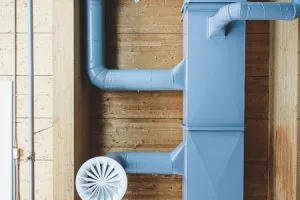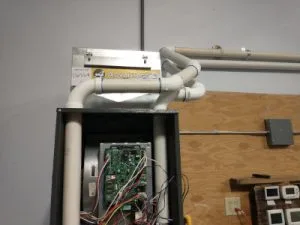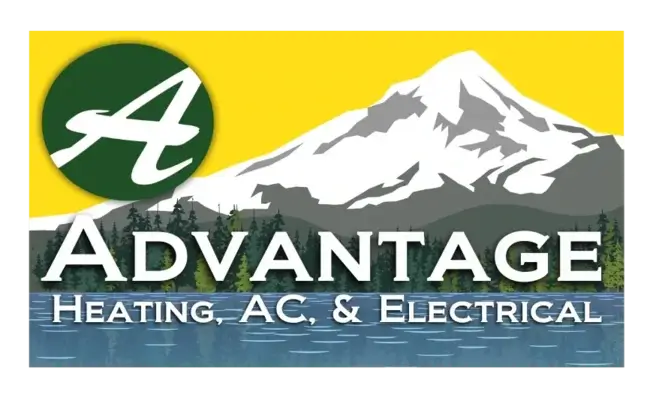Why Is My Furnace Leaking Water?
Water damage is no one’s friend. So if your furnace is leaking water, you might understandably be pretty concerned. In most cases, this can be a quick repair, so don’t worry. However, you will want to act fast.
Leaking water can cause mold growth that could pose a health risk and lead to poor indoor air quality.
The most common cause of a furnace leaking is a condensation leak.

Furnace Condensation Leaks
In most cases, the fix is quick and easy. Even if it is a quick fix, you will want an HVAC professional to inspect your furnace and perform the repair. They will determine if it is one of the common quick fixes or if it is something worse.
A furnace leaking water could also mean that something will need a more substantial repair. Remember to not panic. That is the absolute worst-case scenario, and if your furnace is under warranty, that warranty could cover some or all of the repair.
In this post, we’ll give you the tools to get an idea of what went wrong. Hopefully, this will give you more peace of mind and allow you to have a more informed conversation with your HVAC professional.
Types of Furnace
The first step in diagnosing what went wrong is to determine what type of furnace you have.
There are two types of furnace: condensing and non-condensing. A condensing furnace, also known as a high-efficiency furnace, extracts heat from combustible gas over a longer time. This long process gives time for the gas to cool and condense.

A non-condensing furnace is less efficient. The gas is burned and then quickly vented out the exhaust or flue.
You will need to know what kind of furnace you have because they could leak water for different reasons.
How to Tell What Kind of Furnace You Have
It’s actually pretty easy to determine what kind of furnace you have. There are two things you need to look for.
- The AFUE (Efficiency Rating)
- The Type of Piping
The first thing to look for is the efficiency rating (AFUE). There is usually a yellow sticker on the furnace that lists the AFUE. All furnaces sold in the United States have an efficiency rating and they must have a label.
If the furnace has a rating of 90% or above, it is a high-efficiency furnace.
When looking at the pipes coming out of the furnace, look to see if they are white plastic (PVC) or metal. Keep in mind these are separate pipes and not your ductwork. If they are plastic, then they carry condensation away from the furnace. If the pipes are metal, they are the exhaust for a non-condensing furnace.
Remember, if it’s high efficiency with plastic pipes, it’s a condensing furnace. If neither is true, it’s non-condensing.

Low-Efficiency Furnace Leaking Water
Since a low-efficiency furnace does not allow gas to cool and condense, it should not be able to leak condensation.
What might happen is that the exhaust or flue is the wrong size. If the gas cannot get vented and becomes trapped, it will cool over time and condense. The metal piping traps that condensation and it will leak.
High-Efficiency Furnace Leaking Water
High-Efficiency furnaces allow gas to condense, so this could be a symptom of one of many issues. Most of these are easy to fix for an HVAC professional, but it’s also possible that something worse is happening.
Easy Repairs
There are four common issues that can lead to a condensation leak.
- Clogged Condensation Drain
- Break in the Condensation Line
- Issues with the Condensate Pump
- Break or Build-Up in the Condensate Trap
These fixes should all be fairly easy and quick for a skilled HVAC professional.
Worst Case Scenario
The absolute worst-case scenario is a faulty secondary furnace heat exchanger. This is the portion of the furnace where it pulls heat from gas as it cools. If this portion of the furnace stops working, the repair is going to be costly and intensive. In most cases, this results in a full furnace replacement.
Other HVAC Equipment Problems
As we have discussed in the past, an HVAC system is a bunch of unique pieces of equipment working together. It is possible that something else has gone wrong with another piece of equipment.
Air Conditioner
Some AC units share an internal drain with the furnace. If that drain gets clogged or plugged, it’s possible that the condensation will back up through your furnace. This will look like your furnace is leaking water.
Home Humidifier
Some homes have whole home humidifiers that are connected to the furnace. If you have one of these, it’s possible that the humidifier is leaking. If the humidifier is leaking condensation, it will also look like the furnace is leaking water.
Regular HVAC maintenance can catch this problem early on and prevent it from escalating.

Mitigating a Furnace Leaking Water
If you have just spotted what looks like water coming from your furnace, the first thing you should do is contact your local HVAC professional. Not only will they be able to repair the leak, but they will also be able to see if it’s a symptom of something bigger. They will also know where to check to see if there is mold or buildup that will affect your indoor air quality.
In the meantime, there are a few steps you can take to reduce the chance of mold or damage to your home.
- Shut off your furnace
- Clean up the water around the furnace
- Use a wet/dry vacuum if there is a substantial leak
- Clear the surrounding area of items
Who Are Advantage Heating and Air Conditioning?
We are your local HVAC Experts out of Salem, Oregon. We hope this article gave you some insight to why your furnace is leaking water and how to handle it. If you have questions about HVAC Systems, please check out our other blogs. If you want to know who we are and how we can help, please visit our website and follow us on social media. We’ll be here when you need us.







